Experimental Study of Sulfate Erosion Resistance of Cementitious Sand with Waste Glass Powder
Abstract
1. Introduction
2. Experimental
2.1. Experimental Raw Materials
2.1.1. Cement
2.1.2. Fine Aggregate
2.1.3. Glass Powder
2.2. Pilot Program
3. Experimental Results and Analysis
3.1. The Influence of Sulfate Attack on the Mass Loss of Test Blocks
3.2. Effect of Age on Compressive and Flexural Strengths of the Specimens
3.3. Effect of Dosage on the Sulfate Erosion Resistance of Cementitious Sand
3.4. Effect of Grain Size on Sulfate Erosion Resistance of Cementitious Sand
4. Conclusions
Author Contributions
Funding
Institutional Review Board Statement
Informed Consent Statement
Data Availability Statement
Acknowledgments
Conflicts of Interest
References
- Majchrowska, S.; Mikołajczyk, A.; Ferlin, M.; Klawikowska, Z.; Plantykow, M.A.; Kwasigroch, A.; Majek, K. Deep learning-based waste detection in natural and urban environments. Waste Manag. 2022, 138, 274–284. [Google Scholar] [CrossRef] [PubMed]
- Kim, K. Valuable Recycling of waste glass generated from the liquid crystal display panel industry. J. Clean. Prod. 2018, 174, 191–198. [Google Scholar] [CrossRef]
- Eun, H.T.; Kang, S.G.; Kim, Y.T.; Lee, G.K.; Kim, J.H. Heavy Metal Leaching Behavior of Glasses Containing EAF Dust. Mater. Sci. Forum 2005, 486–487, 382–386. [Google Scholar] [CrossRef]
- Limbachiya, M.C. Bulk engineering and durability properties of washed glass sand concrete. Constr. Build. Mater. 2009, 23, 1078–1083. [Google Scholar] [CrossRef]
- Fanijo, E.O.; Kassem, E.; Ibrahim, A. ASR mitigation using binary and ternary blends with waste glass powder. Constr. Build. Mater. 2021, 280, 122425. [Google Scholar] [CrossRef]
- Chen, Z.; Wang, Y.; Liao, S.; Huang, Y. Grinding kinetics of waste glass powder and its composite effect as pozzolanic admixture in cement concrete. Constr. Build. Mater. 2020, 239, 117876. [Google Scholar] [CrossRef]
- Xiong, X.; Wu, M.; Shen, W.; Li, J.; Zhao, D.; Li, P.; Wu, J. Performance and microstructure of ultra-high-performance concrete (UHPC)with silica fume replaced by inert mineral powders. Constr. Build. Mater. 2022, 327, 126996. [Google Scholar] [CrossRef]
- Martín, C.M.; Scarponi, N.B.; Villagrán, Y.A.; Manzanal, D.G.; Piqué, T.M. Pozzolanic activity quantification of hollow glass microspheres. Cem. Concr. Compos. 2021, 118, 103981. [Google Scholar] [CrossRef]
- Amaral, M.; Macioski, G.; Medeiros, M.H.F.D. Atividade pozolânica da sílica ativa:análise em pastas cimentícias com diferentes teores de substituição. Matéria 2021, 26, e13023. [Google Scholar]
- Song, J.; Feng, S.; Xiong, R.; Ouyang, Y.; Zeng, Q.; Zhu, J.; Zhang, C. Mechanical properties, pozzolanic activity and volume stability of copper slag-filled cementitious materials. Mater. Sci. 2019, 26, 218–224. [Google Scholar] [CrossRef]
- Khan, Q.S.; Sheikh, M.N.; McCarthy, T.J.; Robati, M.; Allen, M. Experimental investigation on foam concrete without and with recycled glass powder:A sustainable solution for future construction. Constr. Build. Mater. 2019, 201, 369–379. [Google Scholar] [CrossRef]
- Khmiri, A.; Chaaboubi, M.; Samet, B. Chemical behaviour of ground waste glass when used as partial cement replacement in mortars. Constr. Build. Mater. 2013, 44, 74–80. [Google Scholar] [CrossRef]
- Patel, D.; Shrivastava, R.; Tiwari, R.P.; Yadav, R.K. Properties of cement mortar in substitution with waste fine glass powder and environmental impact study. J. Build. Eng. 2020, 27, 100940. [Google Scholar] [CrossRef]
- Zhao, Y.; Gao, J.; Wu, S.; Li, Q. Strength development and microcosmic mechanism of waste glass powder cement mortar. J. Exp. Nanosci. 2022, 17, 564–584. [Google Scholar] [CrossRef]
- Borges, A.L.; Soares, S.M.; Freitas, T.O.G.; Oliveira Júnior, A.D.; Ferreira, E.B.; Ferreira, F.G.D.S. Evaluation of the Pozzolanic Activity of Glass Powder in Three Maximum Grain Sizes. Mater. Res. 2021, 24, e20200496. [Google Scholar] [CrossRef]
- Shi, C.; Wu, Y.; Riefler, C.; Wang, H. Characteristics and pozzolanic reactivity of glass powders. Cem. Concr. Res. 2005, 35, 987–993. [Google Scholar] [CrossRef]
- Kalakada, Z.; Doh, J.H.; Chowdhury, S. Glass powder as replacement of cement for concrete–an investigative study. Eur. J. Environ. Civ. Eng. 2022, 26, 1046–1063. [Google Scholar] [CrossRef]
- Kalakada, Z.; Doh, J.H.; Zi, G. Utilisation of coarse glass powder as pozzolanic cement—A mix design investigation. Constr. Build. Mater. 2020, 240, 117916. [Google Scholar] [CrossRef]
- Matos, A.M.; Sousa-Coutinho, J. Waste glass powder in cement:macro and micro scale study. Adv. Cem. Res. 2016, 28, 423–432. [Google Scholar] [CrossRef]
- Siad, H.; Lachemi, M.; Sahmaran, M.; Hossain, K.M.A. Effect of glass powder on sulfuric acid resistance of cementitious materials. Constr. Build. Mater. 2016, 113, 163–173. [Google Scholar] [CrossRef]
- Tang, Z.; Li, W.; Ke, G.; Zhou, J.L.; Tam, V.W. Sulfate attack resistance of sustainable concrete incorporating various industrial solid wastes. J. Clean. Prod. 2019, 218, 810–822. [Google Scholar] [CrossRef]
- Jain, K.L.; Sancheti, G.; Gupta, L.K. Durability performance of waste granite and glass powder added concrete. Constr. Build. Mater. 2020, 252, 119075. [Google Scholar] [CrossRef]
- Xu, Y.; He, T. Effect of Mitigating Strength Retrogradation of Alkali Accelerator by the Synergism of Sodium Sulfate and Waste Glass Powder. J. Renew. Mater. 2021, 9, 1991–1999. [Google Scholar] [CrossRef]
- Rashidian-Dezfouli, H.; Rangaraju, P.R. A comparative study on the durability of geopolymers produced with ground glass fiber, fly ash, and glass-powder in sodium sulfate solution. Constr. Build. Mater. 2017, 153, 996–1009. [Google Scholar] [CrossRef]
- Lu, J.X.; Zhan, B.J.; Duan, Z.H.; Poon, C.S. Using glass powder to improve the durability of architectural mortar prepared with glass aggregates. Mater. Des. 2017, 135, 102–111. [Google Scholar] [CrossRef]
- Shalan, A.H.; El-Gohary, M.M. Long-Term Sulfate Resistance of Blended Cement Concrete with Waste Glass Powder. Pract. Period. Struct. Des. Constr. 2022, 27, 04022047. [Google Scholar] [CrossRef]
- GB/T749-2008; Test Method For Determing Capability of Resisting Sulfate Corrode of Cement. China Standard Publishing House: Beijing, China, 2008. (In Chinese)
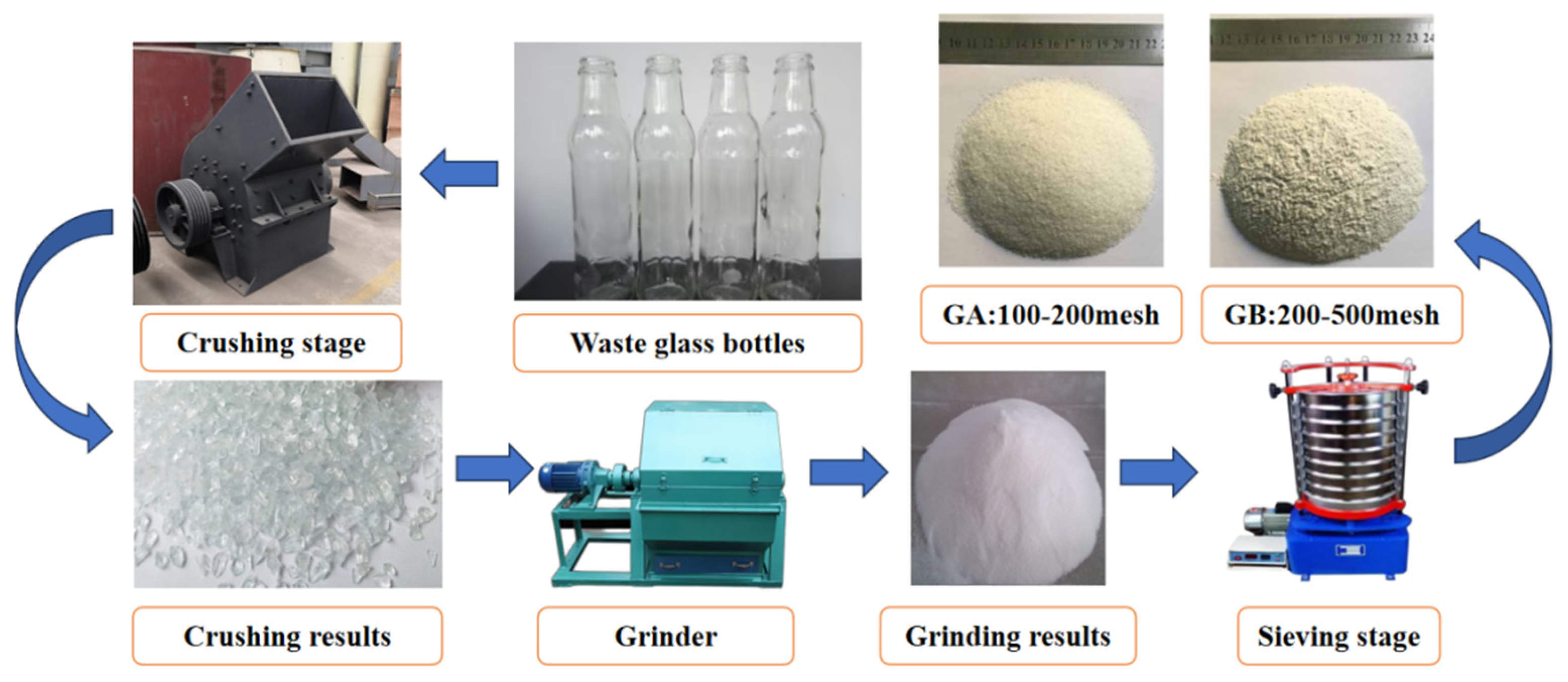
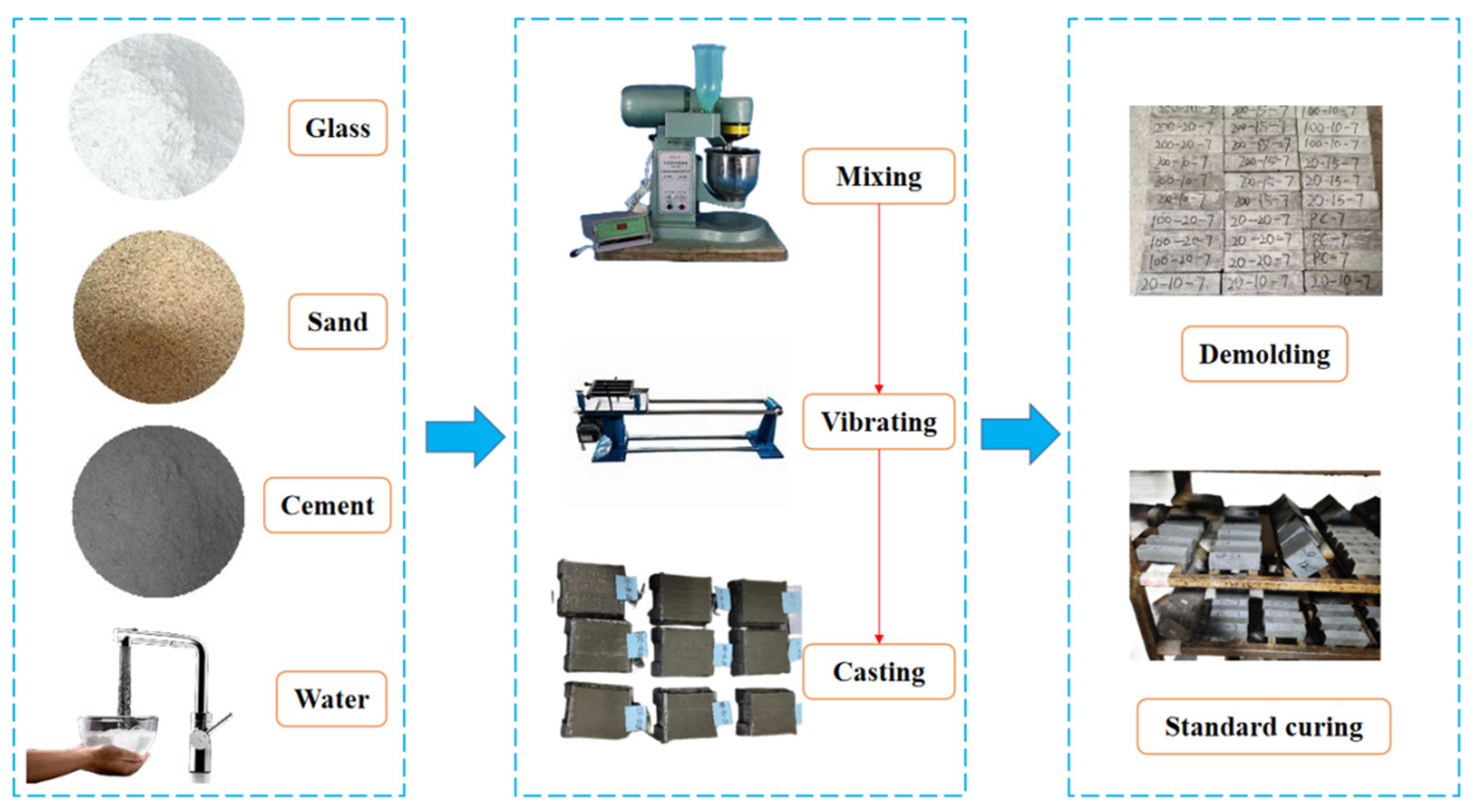


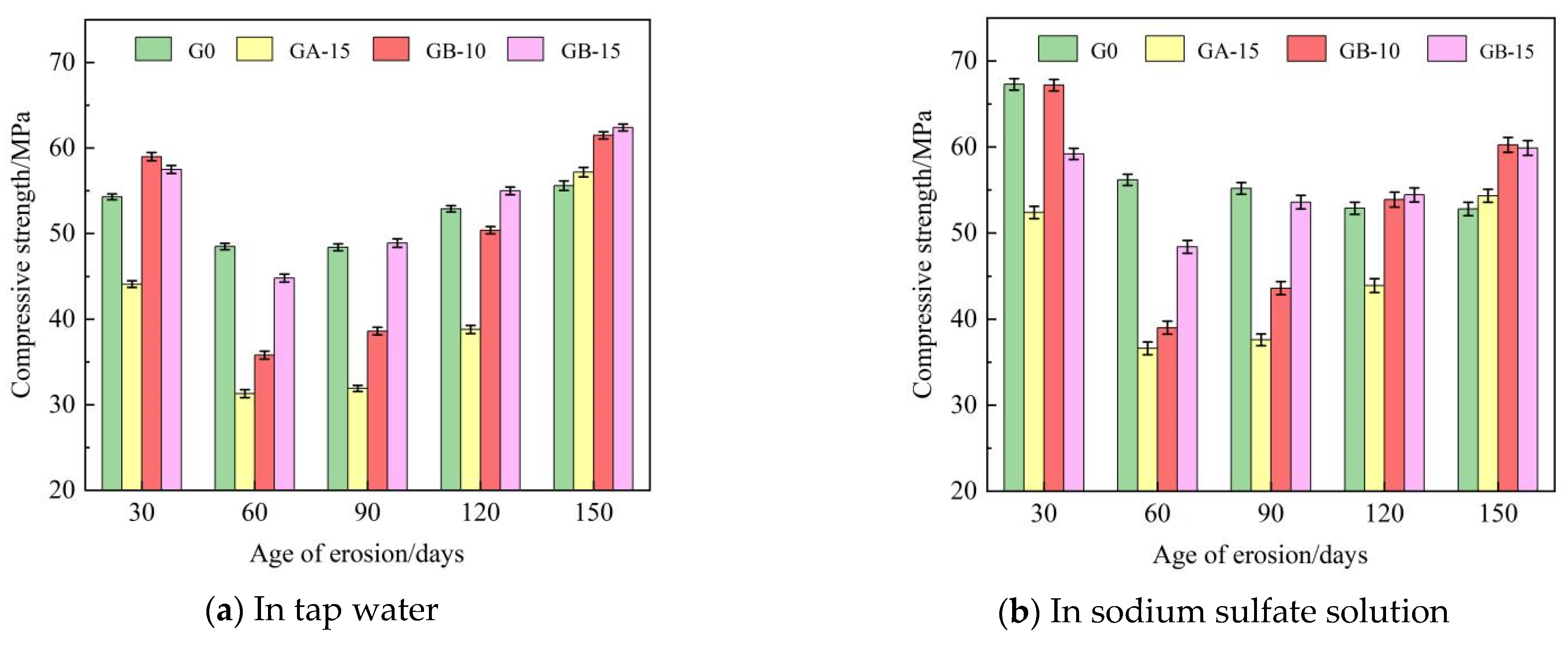
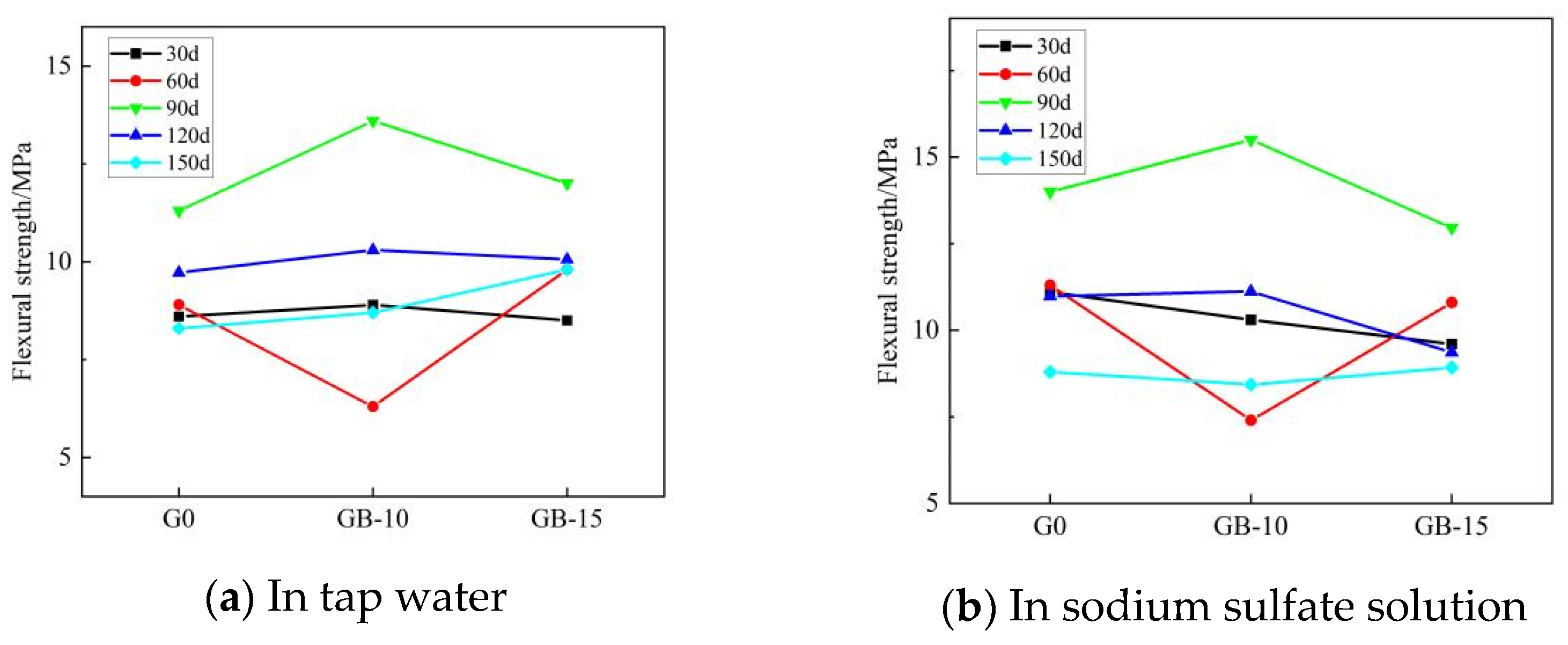
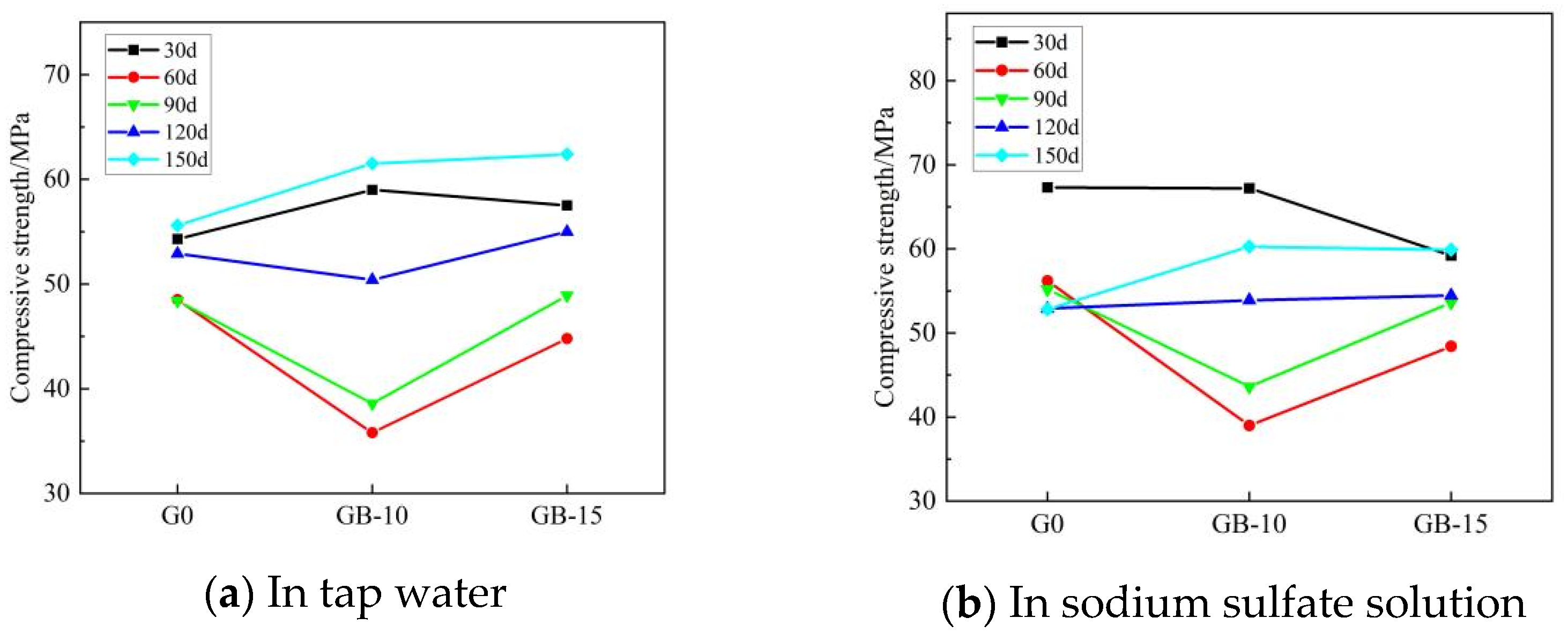

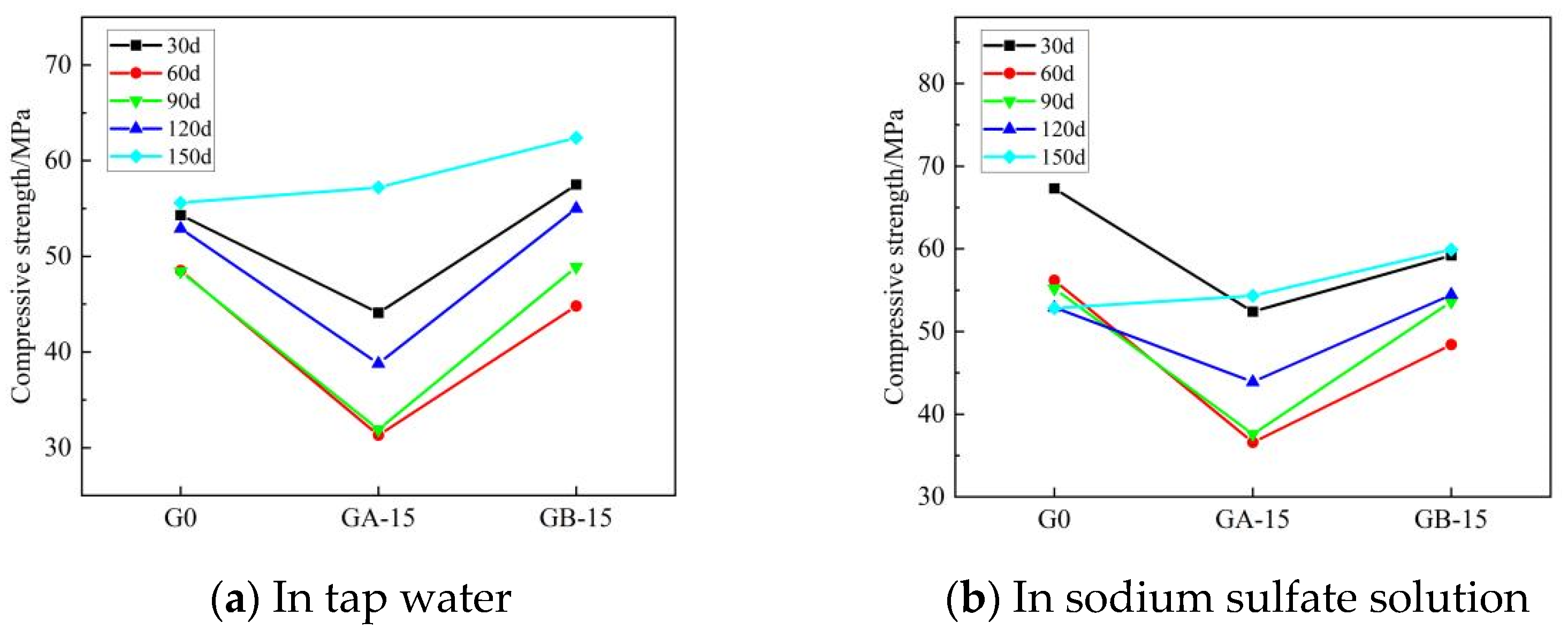
| Product | Specific Surface Area | Density | Setting Time/min | Compressive Strength/MPa | Bending Strength/MPa | |||
|---|---|---|---|---|---|---|---|---|
| cm²/g | g/cm² | Initial Set | Final Set | 3 d | 28 d | 3 d | 28 d | |
| cement | 3320 | 3.02 | 120 | 200 | 24.3 | 45.2 | 4.9 | 7.2 |
| Ingredient | SiO2 | Al2O3 | Na2O3 | CaO | MgO | SO3 | Loss on Ignition | Total Alkali Content |
|---|---|---|---|---|---|---|---|---|
| percentage share | 19.61 | 4.32 | 0.79 | 60.87 | 2.41 | 2.54 | 3.35 | 0.72 |
| Ingredient | SiO2 | Fe2O3 | Cr2O3 | Al2O3 | V2O5 | TiO2 | ZrO2 |
|---|---|---|---|---|---|---|---|
| percentage share | 94.09 | 2.23 | 1.19 | 1.06 | 0.68 | 0.54 | 0.21 |
| Erosion Age/Days | G0 | GA-15 | GB-10 | GB-15 |
|---|---|---|---|---|
| 0 | 0 | 0 | 0 | 0 |
| 30 | 0.9943 | 1.0041 | 1.0122 | 1.0148 |
| 60 | 1.0264 | 1.0104 | 1.0064 | 1.0021 |
| 90 | 0.9983 | 0.9974 | 1.0040 | 1.0012 |
| 120 | 0.9822 | 0.9932 | 1.0010 | 0.9925 |
| 150 | 0.9684 | 0.9811 | 0.9869 | 0.9887 |
| Erosion Age/Day | 30 | 60 | 90 | 120 | 150 | |||||
|---|---|---|---|---|---|---|---|---|---|---|
| Flexural Strength | Compressive Strength | Flexural Strength | Compressive Strength | Flexural Strength | Compressive Strength | Flexural Strength | Compressive Strength | Flexural Strength | Compressive Strength | |
| G0 | 8.6 | 54.3 | 8.9 | 48.5 | 11.3 | 48.4 | 9.72 | 52.9 | 8.3 | 55.6 |
| G-100-15 | 7.0 | 44.1 | 6.5 | 31.3 | 9.8 | 31.9 | 8.39 | 38.8 | 9.7 | 57.2 |
| G-200-10 | 8.9 | 59 | 6.3 | 35.8 | 13.6 | 38.6 | 10.30 | 50.4 | 8.7 | 61.5 |
| G-200-15 | 8.5 | 57.5 | 9.8 | 44.8 | 12.0 | 48.9 | 10.06 | 55 | 9.8 | 62.4 |
| Erosion Age/Day | 30 | 60 | 90 | 120 | 150 | |||||
|---|---|---|---|---|---|---|---|---|---|---|
| Flexural Strength | Compressive Strength | Flexural Strength | Compressive Strength | Flexural Strength | Compressive Strength | Flexural Strength | Compressive Strength | Flexural Strength | Compressive Strength | |
| G0 | 11.1 | 67.3 | 11.3 | 56.2 | 14 | 55.2 | 10.98 | 52.9 | 8.8 | 52.82 |
| G-100-15 | 8.3 | 52.4 | 7.5 | 36.6 | 10.7 | 37.6 | 8.64 | 43.9 | 9.21 | 54.34 |
| G-200-10 | 10.3 | 67.2 | 7.4 | 39 | 15.5 | 43.6 | 11.12 | 53.9 | 8.43 | 60.27 |
| G-200-15 | 9.6 | 59.2 | 10.8 | 48.4 | 12.96 | 53.6 | 9.36 | 54.45 | 8.92 | 59.9 |
Disclaimer/Publisher’s Note: The statements, opinions and data contained in all publications are solely those of the individual author(s) and contributor(s) and not of MDPI and/or the editor(s). MDPI and/or the editor(s) disclaim responsibility for any injury to people or property resulting from any ideas, methods, instructions or products referred to in the content. |
© 2023 by the authors. Licensee MDPI, Basel, Switzerland. This article is an open access article distributed under the terms and conditions of the Creative Commons Attribution (CC BY) license (https://creativecommons.org/licenses/by/4.0/).
Share and Cite
Yu, S.; Wu, S.; Zhao, Y.; Yang, H. Experimental Study of Sulfate Erosion Resistance of Cementitious Sand with Waste Glass Powder. Buildings 2023, 13, 2037. https://doi.org/10.3390/buildings13082037
Yu S, Wu S, Zhao Y, Yang H. Experimental Study of Sulfate Erosion Resistance of Cementitious Sand with Waste Glass Powder. Buildings. 2023; 13(8):2037. https://doi.org/10.3390/buildings13082037
Chicago/Turabian StyleYu, Shuisheng, Shuai Wu, Yi Zhao, and Honghao Yang. 2023. "Experimental Study of Sulfate Erosion Resistance of Cementitious Sand with Waste Glass Powder" Buildings 13, no. 8: 2037. https://doi.org/10.3390/buildings13082037
APA StyleYu, S., Wu, S., Zhao, Y., & Yang, H. (2023). Experimental Study of Sulfate Erosion Resistance of Cementitious Sand with Waste Glass Powder. Buildings, 13(8), 2037. https://doi.org/10.3390/buildings13082037







